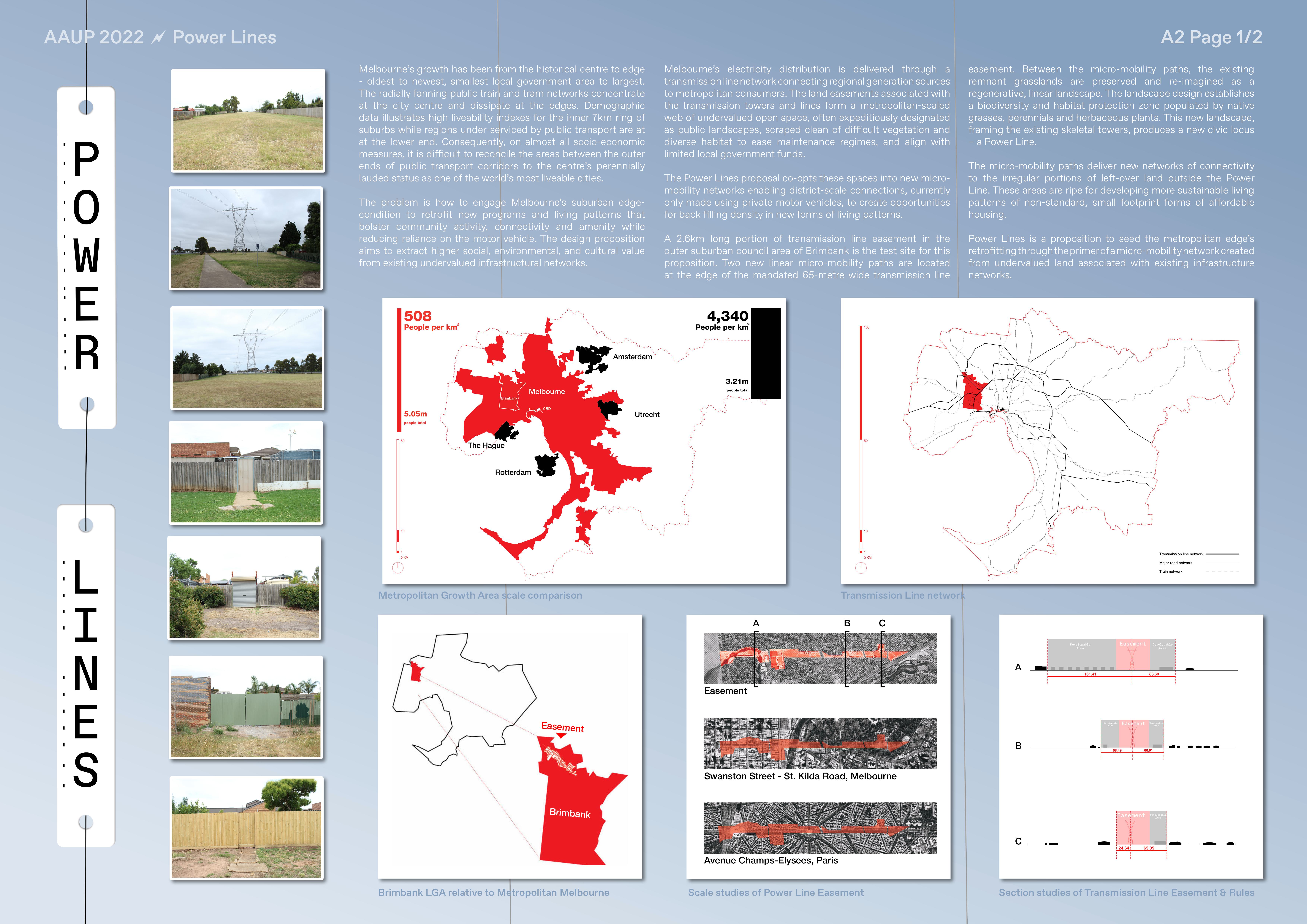Power Lines (2023)
Melbourne’s growth has been from the historical centre to edge
- oldest to newest, smallest local government area to largest.
The radially fanning public train and tram networks concentrate
at the city centre and dissipate at the edges. Demographic
data illustrates high liveability indexes for the inner 7km ring of
suburbs while regions under-serviced by public transport are at
at the lower end. Consequently, on almost all socio-economic
measures, it is difficult to reconcile the areas between the outer
ends of public transport corridors to the centre’s perennially
lauded status as one of the world’s most liveable cities.
The problem is how to engage Melbourne’s suburban edgecondition to retrofit new programs and living patterns that bolster community activity, connectivity and amenity while reducing reliance on the motor vehicle. The design proposition aims to extract higher social, environmental, and cultural value from existing undervalued infrastructural networks.
Melbourne’s electricity distribution is delivered through a transmission line network connecting regional generation sources to metropolitan consumers. The land easements associated with the transmission towers and lines form a metropolitan-scaled web of undervalued open space, often expeditiously designated as public landscapes, scraped clean of difficult vegetation and diverse habitat to ease maintenance regimes, and align with limited local government funds.
The Power Lines proposal co-opts these spaces into new micromobility networks enabling district-scale connections, currently only made using private motor vehicles, to create opportunities for back filling density in new forms of living patterns.
A 2.6km long portion of transmission line easement in the outer suburban council area of Brimbank is the test site for this proposition. Two new linear micro-mobility paths are located at the edge of the mandated 65-metre wide transmission line easement. Between the micro-mobility paths, the existing remnant grasslands are preserved and re-imagined as a regenerative, linear landscape. The landscape design establishes a biodiversity and habitat protection zone populated by native grasses, perennials and herbaceous plants. This new landscape, framing the existing skeletal towers, produces a new civic locus – a Power Line.
The micro-mobility paths deliver new networks of connectivity to the irregular portions of left-over land outside the Power Line. These areas are ripe for developing more sustainable living patterns of non-standard, small footprint forms of affordable housing.
Power Lines is a proposition to seed the metropolitan edge’s retrofitting through the primer of a micro-mobility network created from undervalued land associated with existing infrastructure networks.
The problem is how to engage Melbourne’s suburban edgecondition to retrofit new programs and living patterns that bolster community activity, connectivity and amenity while reducing reliance on the motor vehicle. The design proposition aims to extract higher social, environmental, and cultural value from existing undervalued infrastructural networks.
Melbourne’s electricity distribution is delivered through a transmission line network connecting regional generation sources to metropolitan consumers. The land easements associated with the transmission towers and lines form a metropolitan-scaled web of undervalued open space, often expeditiously designated as public landscapes, scraped clean of difficult vegetation and diverse habitat to ease maintenance regimes, and align with limited local government funds.
The Power Lines proposal co-opts these spaces into new micromobility networks enabling district-scale connections, currently only made using private motor vehicles, to create opportunities for back filling density in new forms of living patterns.
A 2.6km long portion of transmission line easement in the outer suburban council area of Brimbank is the test site for this proposition. Two new linear micro-mobility paths are located at the edge of the mandated 65-metre wide transmission line easement. Between the micro-mobility paths, the existing remnant grasslands are preserved and re-imagined as a regenerative, linear landscape. The landscape design establishes a biodiversity and habitat protection zone populated by native grasses, perennials and herbaceous plants. This new landscape, framing the existing skeletal towers, produces a new civic locus – a Power Line.
The micro-mobility paths deliver new networks of connectivity to the irregular portions of left-over land outside the Power Line. These areas are ripe for developing more sustainable living patterns of non-standard, small footprint forms of affordable housing.
Power Lines is a proposition to seed the metropolitan edge’s retrofitting through the primer of a micro-mobility network created from undervalued land associated with existing infrastructure networks.










“Power Lines”
Architecture Australia Unbuilt Prize (2023)
Collaborators:
(M@Studio)
Dean Boothroyd
Esteban Montecinos
Liam Oxlade
Olivia O’Donnell
Michael Lopes-Vieira